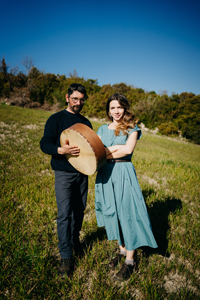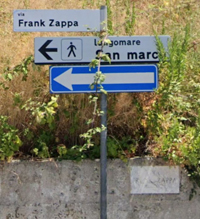Hiram Salsano: Bringing new life to the old songs from Campania.
15. 2. 2024 | Rubriky: Articles,Interviews
For fifteen years she studied rural songs south of Naples. Her album Bucolica is one of the best roots recordings of 2023.
 [Petr Dorůžka, Praha] How would collectors like Béla Bartók or Leoš Janáček work if they lived today? Endangered traditions they managed to capture have definitely disappeared in some regions, but they still live elsewhere. Hiram Salsano was born in Agropoli, a seaside resort 120 km south of Naples. Since 2005, she has been visiting rural farms in the interior and recording the songs of the oldest living witnesses.
[Petr Dorůžka, Praha] How would collectors like Béla Bartók or Leoš Janáček work if they lived today? Endangered traditions they managed to capture have definitely disappeared in some regions, but they still live elsewhere. Hiram Salsano was born in Agropoli, a seaside resort 120 km south of Naples. Since 2005, she has been visiting rural farms in the interior and recording the songs of the oldest living witnesses.
It is easy to find parallels of her work in a wider context. The American folklorist Alan Lomax is known primarily for the recordings of black bluesmen from the south of the United States, but his later collecting work in Europe, including Italy, was no less important. On his Italian expedition he worked with Diego Carpitella, a professor of ethnomusicology who was nine years his junior. Lomax discovered that Italian regional music was at least as varied as American music due to its geographical distribution. “Strange as it is,” he wrote, “true Italian folk music is unknown even to the Italian population, not to mention the rest of the world.” When he and Carpitella toured the countryside, they were often greeted by the local mayor, unaware that the collectors would try to escape the authorities as quickly as possible to contact the local janitor or cleaner, who would more likely lead them to the real source. In his diary, Lomax writes: “Day after day I encountered ancient and completely unknown styles. I began to understand how the enlightened people of the Renaissance felt when they discovered these buried and hidden treasures of Greek and Roman antiquity.” This is just to explain that the Italian musical heritage has a centuries-tested endurance, and it is therefore not surprising that Hiram Salsano, 60 years after Lomax, still had something to discover. She transformed the results of her research into her album Bucolica, which attracted the attention of specialized world critics in 2023. You can see the whole survey on her own website https://www.hiramsalsano.com/home-page/press,
read the detailed Andrew Cronshaw’s review here https://www.rootsworld.com/reviews/salsano-23.shtml and
Ciro De Rosa’s interview here https://www.blogfoolk.com/2023/06/hiram-salsano-bucolica-autoprodotto-2023.html.
In October 2023, the singer won the International Jury Prize at the Premio Andrea Parodi competition in Sardinia.
In recent years, Italian music has become better known thanks to pizzica, the tambourine driven rhythm from Salento. What kind of secrets do we find in music from Campania?
Traditional music from Campania retains several peculiarities. One is a rather personal use of the voice. Voices in Campania are articulate, rich in melismas, and do not refer to the tonal system but to the modal system. Melodies are enriched with microtones that would not be possible to reproduce even with western notation methods. Among the instruments, the most common is the chitarra battente, that is, the guitar used as percussion, the shawm, tambourines, accordion and bagpipes.
If we go back in history, did polyphony exist in Campania? How is the local tarantella similar to or different from the Salento pizzica?
There was and is polyphony in Campania, which is still alive today. We find devotional songs, work songs, songs of departure, songs of distance, and love songs in various areas of Campania where they are still sung in several voices. For example, one type of our traditional songs is called “alla longa”, with two voices that go into polyphony and meet in unison in the final note. Local tarantellas are certainly related to the pizzica and other forms of tarantella found throughout southern Italy.The tarantellas present in the various regions are all different. There are cases in which several ways of playing the tarantella have developed in the same region. For example, in Campania, the tarantellas of Avellino (Montemarano) are different from those of Cilento.
 An important part of the story is when Alan Lomax explored Italian music with Diego Carpitella. Did they make recordings in Campania?
An important part of the story is when Alan Lomax explored Italian music with Diego Carpitella. Did they make recordings in Campania?
In 1954, Lomax’s expedition investigated all the regions of Italy. In his passage through Campania he collected interesting testimonies. Some tracks recorded in Campania were used as the soundtrack for the film Il Decamerone by Pier Paolo Pasolini. The track ‘Cicci’ on my album is based, among other things, on a recording by Lomax, a drum track collected in Pagani (Salerno), where the rhythmic session is performed by voices instead of the drum.
Campania is probably the only Italian region whose name is not taken from a specific place but has a more general meaning: campo is a field, campagna is countryside. Is there a real story behind this? And is Campania more ‘rural’ than neighbour regions like Basilicata or Calabria?
Surely a historian or scholar could tell us more. In general, the word Campania indicates a flat and fertile area, Campania felix, the ancient territory of Capua in Roman times. Today, Campania is a very urbanized region, even though it retains large green and rural areas, Cilento being one of them. We find a ‘Lucanian’ culture linked to the ancient borders, and we still find a lot in common with Basilicata and northern Calabria.
You have called your CD Bucolica. Would the translation be very close to the word ‘rural’?
The name Bucolica derives from the adjective bucolic, i.e., pastoral, which I then transformed into feminine. I chose this name because it anticipated the concept of music from southern Italy that I wanted to express.
You studied at the Goetheanum, was that in Switzerland?
Yes, I studied at the Euritmeum Zuccoli of the Goetheanum in Dornach, Switzerland. I took a course in eurythmy, an art of movement devised by Rudolf Steiner at the beginning of the 20th century.

Actually, it is a university focused on anthroposophy, a different discipline from anthropology. In short, you could say that the former studies everything about man not only in the visible aspect (physical) but also in the invisible aspect ;(spirit, soul) the latter, on the other hand, studies everything about man in terms of visible traces, morphology, psychology, etc.
I learned a lot especially in relation to the movement of the body related to the rhythm and harmony of the human being connected to the natural and cosmic elements.
Did you study singing? Or did you simply learn from folk singers?
For several years I studied singing and the ways of musical expression just by listening to various traditional singers. Then I decided to study some basic singing practices such as breathing, emission, intonation, and so on, applying this knowledge to what I was listening to and trying to reproduce.
What is the most important local instrument in Campania?
In the Neapolitan area, the main instrument is the ‘o Tammurre, a frame drum with a diameter of 35 to 45 cm. It is a wooden hoop with a goat skin and tin rattles. It has a different shape from the current tambourines used for the pizzica in Salento. Each player chooses the diameter that is most comfortable for him.
How did you carry out your research? Did you travel with a tape recorder and visit families?
We went to look for elders who possessed knowledge not only in music but also in agriculture and, above all, in humans. They passed on values and songs that we tried to learn. Our research was related to practice and not to the acquisition of material to fill an archive. We wanted to learn from them. We recorded on a Panasonic minidisk.
The Cilento region is known for its beaches and tourist crowds. It is surprising that unknown musical tradition still survives in the area. Where exactly did you find your sources?
My research was based on two areas of personal experience: the Lattari Mountains, an area on the border between the Gulf of Naples and the Gulf of Salerno, and the Alburni Mountains, which lie at the gateway to the current Cilento Park. For the Monti Lattari, I investigated the municipalities of Agerola, Pimonte, Castellammare di Stabia, Gragnano, and Sant’Antonio Abate, listening to work songs, devotional songs, and dance songs, i.e., those sung to the rhythm of the drum.
In the Alburni area, in the province of Salerno, in the municipalities of Postiglione, Sicignano, Castelcivita, Corleto Monforte, and so on, I listened to tarantellas, serenades, devotional songs, extended songs, and lullabies.
In each area, I attended festivals and tried to get to know and get in touch with individual performers who were still tied to their native musical repertoires.
How old were the singers you worked with?
The research and learning phase for me started in 2005. I met singers and performers of various ages, born between 1930 and 1960, and each of them left a great testimony to the passage of these musical elements. The older the singers were, the more songs related to the agricultural and pastoral world they knew and remembered.
Were they above all ‘grandmothers’, the last living masters of popular song?
Women knew and handed down their songs, often different from those ;of men. The context changed women often sang in private, for their families, for their children, for their grandchildren, or they accompanied themselves at work. In public, they sang mostly devotional songs. Men, on the other hand, sang not only at work but also at times of public celebration. The women knew a rich repertoire of lullabies, songs dedicated to the various tasks they performed in the countryside, prayers, fairy tales, etc. For example, I also learned a lot from my grandmother, who used to entertain us with her songs and stories during childhood.
Who was the oldest?
As I said before, the oldest was probably born in 1930. In some cases, they only knew how to write ;their first and last name in other cases, they had gone to school up to the third or fifth grade and applied themselves to writing and reading small things.
Did you have to use any ‘tricks’ to get them to sing for you?
Absolutely not, just ask if they knew any songs from the past and they would start singing and remembering. Except on one occasion when the singer could not remember a work song and so had to perform the task to sing and remember, showing that the gesture was related to the melody of the song. Otherwise, they had a great desire to be heard.
Do you remember any funny stories?
Actually, fun was always guaranteed. Along with songs, these farmers and workers had a great sense of humor, and every opportunity was good for joking and playing. Moreover, their stories were really adventurous.
Let us now talk about Naples. The city’s best-known style is the Neapolitan song. Enrico Caruso is known as one of the masters of the genre. But probably this tradition evolved from peasant roots?
Of course the world of cultured city music has always had exchanges and encounters with the music of the countryside. The great performers and writers have always drawn on the indigenous ;musical repertoires for their compositions the song ‘Fenesta ca lucive’, also sung by Caruso, is an example of how a text originally a funeral lamentation then becomes a classical opera.
During your research, did you find anything that could be recognized as the ‘roots’ of opera music or of Neapolitan song?
Certainly there is a type of cultured popular theater, often performed by folk artists, that has evolved over time.
 The Neapolitan singer, director and ethnomusicologist Roberto De Simone, now almost 90, is a specialist in this field.
The Neapolitan singer, director and ethnomusicologist Roberto De Simone, now almost 90, is a specialist in this field.
Since the folk revival in 1960’s, Maestro De Simone’s compositions have brought stories, music, and images belonging to the popular world onto the stage.
One of the streets in Agropoli, where you were born, was in 2008 named after Frank Zappa. Have you, or your musicians, ever listened to Zappa?
I had a very broad musical education Frank Zappa was listened to by my parents and remains in my memories.
At your competition concert of the Premio Andrea Parodi, I’ve heard a little twist in your voice, that sounded like throat singing from Mongolia. Did you study this technique?
You’ve heard right. I was enchanted by Asian throat singing, I started studying it with a colleague, he is a student of the world-famous, originally ??Vietnameseof master Trn Quang Hi. I’m just at the beginning so far, in this truly fascinating technique.
The competition, in which you won the international jury prize, is dedicated to the legacy of the late singer Andrea Parodi. According to the rules, each of the finalists does a coverversion of one of his songs. Which is not just a tribute to his legacy, but a test of creativity to add something extra to a well known song. You accompanied yourself on a rattle, a child’s toy. This was not meant as a joke or provocation, the result was a truly spiritual experience. What was the song about?
I chose Stabat Mater by Parodi, it is a religious song from the Holy Week that precedes Easter. In my home territory there is a strong tradition of Easter songs. I love laments and dirges, it is a genre close to my sensibility. So I have tried to make the piece in the spirit of my nature, adding elements from the Cilento and Sardinia, Andrea’s home region. The wooden thing that I used as a percussion instrument is called ‘zerra’ in our country, it was played at Easter processions. The reason? The church bells are tied at that time, so they don’t ring to commemorate Christ’s death. On the streets you only hear ‘zerre’ [plural of ‘zerra’] and singing liturgical hymns.